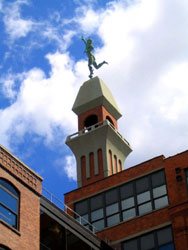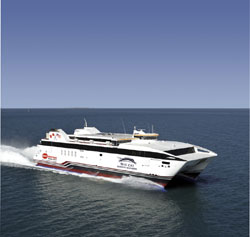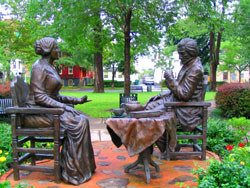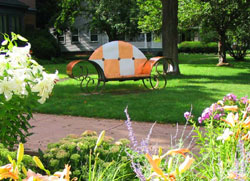My second day in Rochester started off with a lovely Park Avenue neighbourhood breakfast and an exploration of the ArtWalk neighbourhood. I only had a few hours left before I would have to hop back on the high-speed ferry, the CAT, to Toronto, and I definitely wanted to get a more indepth look at some of Rochester’s historical architecture. Rochester is one of those North American cities that has managed to preserve a good portion of its historical masterpieces, despite the “urban renewal” efforts of the 1960s that saw many historic buildings razed and replaced with nameless, faceless skyscrapers and office buildings.
We started our architectural tour right at the foot of the building that fascinated me the most: the Times Square Building. However, an equipment malfunction (i.e. empty batteries) forced me to search for a convenience store, and my local expert Patti came to my aid and took me to another historical building, the Reynolds Arcade, where I was able to replace my batteries and continue my photographic journey.
Rochester has a surprising amount of historical architecture, here is just a tiny sample of some of the well-preserved buildings.
|
|
View of downtown Rochester from the offices of the Visitors Association, an intact 19th century streetscape. |
|
|
The Erie Canal Aqueduct over the Genesee River. The current aqueduct was built in 1842, replacing an earlier one. It was the only aqueduct on the Erie Canal to carry both a water trough and a towpath over a river. |
|
|
A statue of Mercury, dating back to 1881, is located in a cluster of late 19th and early 20th century buildings along the West bank of the river. |
|
|
My favourite building is the Times Square Building, located at the corner of Exchange Bouleavard and Broad Street. It is a dramatic example of Art Deco architecure and was completed in 1930. Talking about the Wings of Progress that crown the building, Ralph T. Walker, member of a New York City architectural firm, was lying on a sandy beach in Florida, “idly molding the sand into tower forms,” when it happened. “I made a model out of beach sand, picking up shells which I could break into the forms I desired,” Walker related. he ended up with a design that gave a “sense of flight…. (a) sense of upward lift” and yet had a “monumental aspect.” |
|
|
Across from the Times Square Building is the Gannett Building, built in 1927 to 1928 as the headquarters and publishing center of the Gannett Company. |
|
|
The Wilder Building is Rochester’s foremost example of Richardsonian Romanesque architecture. It was briefly the tallest building in the city and is a forerunner of modern skyscraper design that emerged in the late 19th century. |
|
|
For many years the Powers Building was the tallest structure in the city. It was built in 1869 for Rochester entrepreneur Daniel Powers. Originally it had five stories and the triple mansard roof and iron tower at the top were later additions. The building is an example of cast iron construction and contains a large open cast-iron staircase. |
|
|
The Reynolds Arcade is another precious example of Art Deco architecture. It replaced an earlier building from 1828 and it housed both the central post office and the city’s first public library. |
|
|
The Academy Building was built between 1872 and 1873 and is a later version of Gothic revival. The building was originally a high school, later became the Municipal Court and Education Building and also served as headquarters for the Board of Education. Today it houses offices and features a dramatically sky lit central atrium. |
|
|
City Hall is the former Federal Building and was built between 1885 and 1889 as a superb example of Richardsonian Romanesque style. The building housed various government operations as well as Rochester’s main post office. The City of Rochester acquired the building in 1975 for $1.00 and started renovation and construction of a 45,000 square foot award winning addition. |
|
|
The elegant three-story atrium inside City Hall features cast-iron work and marble columns and a stone mosaic. It has a glass roof and is often used as a setting for weddings and special events. |
|
|
St. Joseph’s Park is another fascinating structure: it is located in what was the city’s oldest Catholic church, built in 1843 by German immigrants, and was destroyed by fire in 1974. Only the exterior façade remains and the inside of the former church has been turned into a park, with an enclosed courtyard and fountain. It provides a welcome tranquil spot in the downtown area. |
There would have been so many more buildings to see, but my stay in Rochester was rapidly coming to end. My departure on the ferry was scheduled for 3:30 pm and we still had to have lunch and check out the Charlotte area surrounding the Rochester ferry terminal.
So we headed off on the green highways of the city, which is located about 13 km (8 miles) south of Charlotte on Lake Ontario. This time I really enjoyed the drive through the well-manicured streets of Rochester since a crystal-blue sky brought out the vibrant colours of the surrounding scenery.
We had a casual lunch in the bright sunshine on the patio of the Pelican’s Nest restaurant, located right on the Western shore of the Genesee River. The view from the restaurant is great – you get to peak out at an old, now unused swivelling railroad bridge that marks the center of the river. Families of ducks, sail boats and kayakers round out the serene picture.
About half an hour before the departure of the ferry we checked out Ontario Beach Park which features a beautiful sandy beach, a boardwalk, various concession stands, a community center as well as the famous historic Denzel Carousel, created by Gustav A. Denzel, a German immigrant to Philadelphia who opened a cabinet making shop and found his calling in carving horses. He introduced a novel mechanism that allowed the animals on the carousel to go up and down. Today there are only 26 Denzel carousels left, of which 14 are still in operation. Interestingly enough, the only one left in Canada is located in Toronto, in the Centreville Amusement Park, just a ferry ride away from Rochester…
Just minutes before getting on the ferry my local experts Patti and Carrie said they couldn’t let me go before exposing me to another Rochesterian specialty: a sample of Abbot’s frozen custard! I had never tasted frozen custard before, I guess it’s very similar to icecream, just smoother and creamier.
So after a very fulfilling taste of chocolate and almonds I made my way onto the Spirit of Ontario ferry, also referred to as the CAT, and I watched our slow departure from the ferry dock from the top open-air deck of the vessel. As the vessel sped up to its top speed of almost 80 kph (50 mph) I stood out there watching the Port of Rochester and the southern shorelines of Lake Ontario disappear. I thought that I had had a fabulous time in picturesque Rochester, and now that the ferry makes things so much more accessible, I am planning to come back to check out Rochester and its surrounding area in more detail in the future.
 |
 |
 |
| View of the old railroad bridge from the Pelican’s Nest Restaurant in Port Charlotte | The Denzel Carousel, dating back to 1905, just celebrated its 100th anniversary. | Ontario Beach Park at the Port of Rochester, bordered by a beautiful sandy beach on Lake Ontario. |















